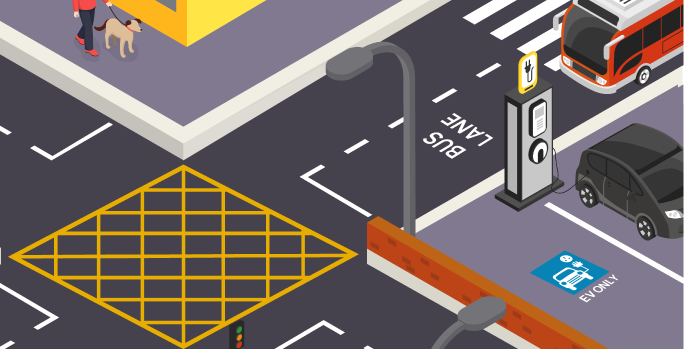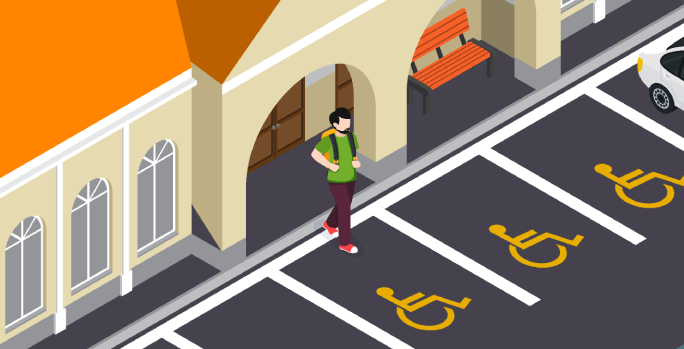Parking spaces are a fundamental part of urban infrastructure, and with the growing diversity of vehicles and use cases, the way we mark and manage parking areas has evolved. Whether for electric vehicles (EVs), disabled access, bicycle sheds, or quick drop-off zones, specific parking markings and layouts ensure proper organisation, accessibility, and safety. In this post, we’ll take a closer look at the various types of parking markings, their use cases, and how they contribute to the efficiency of urban spaces.
1. Electric Vehicle (EV) Parking
With the rise of electric vehicles, designated EV parking spots have become increasingly common in public car parks, residential complexes, and workplaces. These spaces are typically marked with vibrant - often green or blue - lines to distinguish them from regular parking spots. EV charging stations are often integrated within these spaces, providing a direct connection for electric vehicles to charge while parked.
- Why It Matters: Clear, well-marked EV parking ensures that these dedicated spots remain available for electric vehicles, preventing misuse by traditional internal combustion engine cars.
- Markings: EV bays are usually two lines, and marked with symbols indicating the presence of a charging station. On public land, this has to be the S65 symbol, however on private land, this could be a range of designs.

2. Car Parks: General Parking Bays
General parking areas, whether in public car parks or private facilities, are designed to maximise space whilst maintaining an organised layout. Standard white or yellow lines are used to demarcate individual parking bays. These parking spots cater to average-sized vehicles and provide structured, easy-to-navigate spaces for drivers.
- Why It Matters: Properly marked parking bays improve traffic flow and prevent overcrowding in busy car parks. This helps ensure that vehicles can be parked efficiently, leaving enough room for other cars to manoeuvre.
- Markings: In some cases, additional markings, such as arrows or numbers, are used to guide drivers through the car park, improving overall organisation.
3. Disabled Parking
Handicapped parking spaces are essential for ensuring accessibility for individuals with disabilities. These spots are typically placed near building entrances for convenience and are marked with bright blue lines, accompanied by the international disabled symbol on the ground.
- Why It Matters: Providing easy access to buildings and services for people with limited mobility is a legal and moral obligation in most urban areas. These spots ensure that disabled drivers or passengers can park close to their destination without the need to navigate long distances.
- Markings: Disabled parking spaces are often wider than standard spots, providing enough room for wheelchair access or the use of mobility aids. You'll typically find hatched lines around the space to provide additional space around the vehicle for access.

4. Keep Clear Areas
"Keep Clear" markings are essential for maintaining access in areas where vehicles must not park or obstruct pathways. Commonly used in front of fire exits, emergency vehicle zones, and building entrances, these markings use bold yellow lines with "KEEP CLEAR" lettering on the ground.
- Why It Matters: Ensuring that emergency routes, loading bays, and critical access points are kept clear at all times is crucial for safety and efficient building operations.
- Markings: The wording is typically painted within the marked area in large, visible letters, often accompanied by additional signage and hatched lines.
5. Bicycle Areas and Sheds
With more people turning to bicycles for transportation, parking areas for bikes have become common in urban environments. Bicycle parking areas or sheds are typically located in safe, accessible places and are marked with green or white lines, along with bicycle symbols.
- Why It Matters: Clearly marked bicycle parking areas help organise bike traffic, reduce clutter on sidewalks, and ensure that cyclists have dedicated spaces to secure their bikes.
- Markings: Bike symbols are used on the ground, sometimes along with lines demarcating individual slots or racks within the bike parking zone.
6. Motorcycle Parking
Motorcycles require less space than cars, and dedicated motorcycle parking spots make efficient use of available space. These areas are often marked with yellow or white lines and some variation of 'motorcycle only' lettering, helping riders easily identify designated parking areas.
- Why It Matters: Motorcycle-specific parking optimises space usage and prevents motorcycles from parking in car spaces or other inappropriate areas, which could disrupt traffic flow or block access.
- Markings: Similar to bicycle parking, these zones typically include symbols or thermoplastic lettering indicating that the space is reserved for motorcycles.
7. HGV/Motorhome Parking
Parking for heavy goods vehicles (HGVs) and motorhomes is crucial in service stations, rest areas, and large retail or commercial zones. These larger vehicles require more space, and their designated parking spots are typically marked with wider, more robust lines to accommodate the larger dimensions.
- Why It Matters: Dedicated parking areas for HGVs and motorhomes reduce the risk of these vehicles taking up multiple spaces in standard car parks or blocking traffic. In commercial areas, this helps ensure smooth operations by allowing easy loading and unloading.
- Markings: These spaces are typically outlined with thicker white or yellow lines, sometimes accompanied by signage indicating specific weight or vehicle length restrictions.

8. Quick Stay, Drop-off, and Pick-up Areas
Quick stay zones and drop-off/pick-up areas are essential in busy urban areas, airports, schools, and shopping centres. These areas are typically designated with yellow lines and signage that indicates time limits for parking, ensuring a steady flow of traffic.
- Why It Matters: Drop-off and pick-up areas facilitate the smooth movement of vehicles in areas where short-term parking is necessary. Proper markings help avoid congestion and ensure that these zones are used as intended—allowing people to quickly drop off or pick up passengers without obstructing traffic.
- Markings: Bold yellow lines often outline these areas, with clear "DROP OFF ONLY" or "PICK UP" markings on the ground.
Conclusion: The Importance of Diverse Parking Markings
Properly marked parking areas play a crucial role in keeping cities, shopping centres, and other public and residential areas organised and accessible. From EV parking spots to disabled bays, each type of parking area requires specific markings and layouts to ensure ease of use, safety, and efficiency. Whether you’re managing a commercial car park or planning the layout of an urban area, investing in clear, durable parking markings is essential for creating a functional and user-friendly environment.